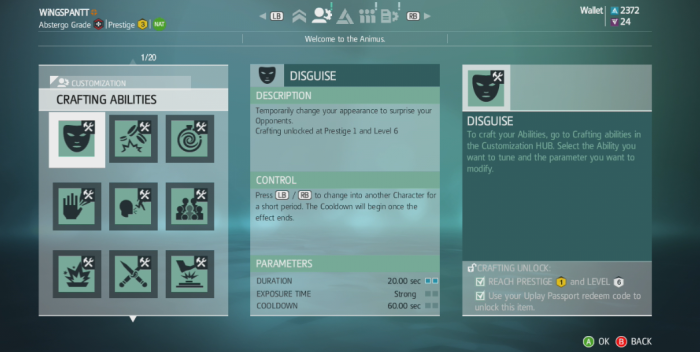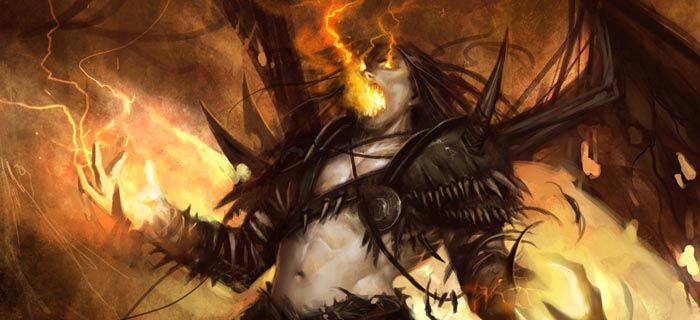AC4 Black Flag multiplayer strategy #16: Abilities Guide (ranged abilities)
Welcome to Part 16 of WiNGSPANTT’s Assassin’s Creed 4: Black Flag multiplayer strategy guide!
Since ranged abilities occupy a unique skill slot that doesn’t compete with other tactical options, choosing the right one is usually easier than homing in on your other abilities. Based on your game mode, play style, and strengths/weaknesses of your main abilities, choose the ranged option that best solves common problems you encounter.
For instance, if you’re playing against overly skittish targets, Throwing Knives or Poison Dart may be necessary to prevent them from getting away. When you’re vying for first place against one particularly competitive player, Disruption or Sabotage can give you a consistent edge. And in situations where everyone seems determined to poach your kills, the Pistol is indispensable… and hilarious.
In addition to overall strategy and bullet-point tips, I’m also including ratings for each Assassin’s Creed 4 ability to give you a quick-glance evaluation. These aren’t the only factors that determine if an ability is good or if you should equip it, but they’re good starting points for discussion.
Versatility: How many different situations can the ability be used in? Contrarily, how often will you wish you had something else equipped? Versatile abilities help you maximize your options and score.
Reliability: How often is this ability available, and what are the odds it will actually succeed? How much of its effect relies on luck, lag, or human stupidity? Reliable skills simply work when you need them to.
High-Scoring: How much will this ability increase your score, or decrease the score of your adversaries? Will equipping this ability directly contribute to your total? High-scoring skills fuel leads and comebacks.
Disruption
- Versatility: 3/5
- Reliability: 5/5
- High-Scoring: 2/5
Disruption is probably the second least popular ranged weapon, right behind Sabotage. It doesn’t kill your target. It doesn’t give you points. And yet, its low cooldown and high versatility mean that even if it’s not the most directly powerful ability at any given moment, it’s always ready to help with the task at hand.
First, you have to understand what Disruption does and what it doesn’t do. It does ruin your opponent’s heads up display and audio. It does put her in an exposing animation. It does drain her approach meter at the end of its duration. Disruption doesn’t remove your enemy’s lock. It doesn’t disable their abilities or actions.
Basically, it just makes it really hard for them to discern what’s going on around them for several seconds. This can be generally useful for approaching any foe. If your pursuer or target hasn’t seen you yet, throw Disruption on her and move in with the confidence of knowing she can’t easily spot or contest you. You don’t have infinite time, but 5-10 seconds should be enough.
If your victim has spotted you, remember that Disruption won’t remove her lock. That said, if you can break LOS for 3 seconds, the lock will be gone and your enemy won’t even realize it. Jog around a corner then pounce from another angle for maximum effect (this is similar to the advice for Time Phase stunning).
Once you’ve mastered this kind of mind games, the next best use for Disruption is simply messing with other players. Dropping a 10-second Disruption on the guy in first place is going to take a toll on his score. He won’t be able to see anything, and other players will spot him more easily thanks to the Animus effect surrounding his persona and the hand-waving animation that accompanies Disruption.
This is particularly useful in Deathmatch, where you can Disrupt the same player 8 or 9 times a match. Check the scoreboard frequently and memorize the persona of your most dangerous opponent, then Disrupt him on sight. In effect, you’ll be robbing him of up to a minute and a half of playtime, giving you a huge advantage in the race to score more!
Disruption Tips
- If you’re using Disruption to drain your pursuers’ approach meters, keep in mind that a longer Disruption duration means it takes longer before their meter is drained.
- Low-level Disruption is pretty much useless. If you want to ruin your prey’s life, you should craft medium or high-level Disruption for greater reliability.
- Disruption is an excellent method for countering an Animus Hack.
- Disrupting your target is unorthodox, but can also lead to their own target stunning them. This could give you an easy, high-scoring kill.
- If Disruption lasts 20 seconds or more, consult your Physician.
Pistol
- Versatility: 3/5
- Reliability: 5/5
- High-Scoring: 2/5
Pistol is almost universally hated among Assassin’s Creed players, and I understand why. It doesn’t take a lot of technical skill to master. It has nearly infinite range and negligible activation time. It’s an easy, no-risk way of eliminating a target. To me, these all sound like tactical benefits.
You already know that Pistol is great for killing runners and roofers. It’s great for poaching kills when you’re sharing a contract with multiple players. These uses help balance Assassin’s Creed multiplayer, preventing the entire game from becoming a constant footrace/parkour orgy. But Pistol serves so many other tactical uses!
First, Pistol is actually pretty good at defense, albeit indirectly. Let’s say you have 3 pursuers, and your target is halfway across the map. You could attempt to safely find, identify, approach, and kill him… but what are the odds you’ll actually make it there without getting gutted? Or let’s say both your target and pursuer are at medium range, but your pursuer is dashing straight at you. What’s it gonna be?
With Pistol, you don’t have to expose yourself for so long to get a kill. Locate your mark at maximum range, aim for 0.75 seconds, and take your “free” 100-250 points. You’ve forfeited a great deal of potential points, but you’ve also saved yourself 15 seconds of walking and 10 seconds of stalking. Not only that, you can off your opponent without a large risk of being murdered halfway through the process. In effect, Pistol gives you more control over the rhythm of the contract system.
The same goes for Assassinate, even though there is no contract system. If you see two players about to interact, you might normally have to sit on the sidelines until one’s dead before moving in and scoring big. With Pistol, you can shoot one of them (preferably the more dangerous adversary), then move directly into assassinating Sucker #2. It’s not the highest scoring method out there, but it’s safe and effective.
Now the downsides of Pistol are obvious. First, it’s completely useless against anyone other than your target. You can’t use it against your pursuers in any way, and you can’t mess with neutral players the way you can with Disruption, Sabotage, or Throwing Knives. In other words, equipping Pistol leaves you significantly more helpless than almost any other ranged ability.
The other downside is the relatively low score potential compared to other ranged skills. Best case scenario, you get some Poacher or Savior bonuses, a Revenge bonus, and Execution, for something like 200 points. Meanwhile, Poison Dart is worth more than that by default, and other skills can trap your opponents in ways that let you set up higher-scoring kills (or any-scoring stuns).
Despite these restrictions, I believe Pistol plays an important role in Assassin’s Creed multiplayer. It gives you flexibility with your contracts, a means to poach from any distance, and a serious means for dealing with runners and roofers. Haters may cry when they die to my Pistol, but that’s their problem, not mine.
Pistol Tips
- With fully crafted aiming time buffs, Pistol can be extremely accurate with only 0.5 seconds of aiming time.
- If aimed at medium range, some targets will rush you for a stun. Cancel your Pistol aiming directly into an Assassination for more points than you would’ve gotten with the ability.
- When you can’t ID a target, aiming Pistol at lookalikes in a crowd can sometimes scare real players into running away. Nail them in the back for a free Execution bonus.
- Pistol can be interrupted by many effects, including Throwing Knives and Wipe, so don’t aim much longer than you have to.
- Taunting after a Pistol kill is extremely rude, and therefore mandatory.
Poison Dart
- Versatility: 2/5
- Reliability: 3/5
- High-Scoring: 5/5
Poison Dart is most closely related to Pistol, being an ability that can kill your target at range. That said, there are a few quirks that make it slightly different to use in practice, so let’s cover them.
Compared to Pistol, Poison Dart is much, much slower. It’s significantly slower to aim, and it takes several seconds to kill your target (leaving you open to an interception). In addition to rooting you in place longer during ability preparation, Poison Dart has a limited range that’s less than a quarter the total distance Pistol can hit. All of these handicaps combined mean that your target must be closer to you, slower to react, farther from cover, and generally less contested as a contract in order for Poison Dart to be effective.
What do you get out of all this? Primarily, just a higher score (a base kill is worth 300 points), and a stealthier execution (there isn’t a loud bang!). Whether these boosts are worth the tradeoff for the instant, long-range assassination of Pistol will depend greatly on the size of the map, mobility of your targets, and the number of players contracted to your target. Choose wisely!
Poison Dart Tips
- It’s important that you move away from your target as soon as you’ve fired Poison Dart. Allowing your target to stun you will cut your score advantage from +300 to +100, at which point you may as well have used Pistol.
- Players hit by a Poison Dart will hear a thwack sound, warning them they’ve been stung.
- Their character will also perform a neck-patting animation, followed by a neck-choking animation. These animations are visible to all players, making interceptions likely.
- Use the long aiming animation and long duration of Poison Darts to trick targets into approaching you. Build up your approach meter by maintaining LOS. Stand near a ledge or wall, then quickly move into a hanging or acrobatic position right before your target reaches you. Intercept your own Poison Dart for a kill worth much more than 300 points!
- WARNING: Always exhale when firing a Poison Dart. Inhalation along either end of the Poison Dart Blowpipe can lead to serious adverse health effects.
Sabotage
- Versatility: 2/5
- Reliability: 3/5
- High-Scoring: 2/5
Sabotage is easily the least popular and least understood ranged ability. It could be that it’s simply too new for old-time Assassin’s Creed players to grasp. Or it could just be that it kind of sucks. I’m gonna go with a little bit of column A, and a little bit of column Suck.
On the misunderstanding front, I find the average player, even the fairly skilled player, doesn’t know what Sabotage does and how they should actually use it. Basically, once you fire it at a player, that player is cursed for X seconds (the ability duration). If she uses any ability within that X seconds, it will be automatically fail and will be unavailable for Y seconds (the lockout duration). Therefore you need to use Sabotage when you anticipate your victim will try to use an ability in the next X seconds. Successfully doing so will ruin their current plans and leave them one ability short for a significant period of time.
As for actually using Sabotage in most game modes, your best bet is either as a supplement to another skill or as a score denial/starvation tactic. Activating Sabotage directly before something like Time Phase greatly decreases the odds that your opponent will successfully counter your approach with an ability. Hell, most players aren’t used to using or being inflicted with Sabotage, so half the time they’ll get so thrown off by their ability failing that they’re completely flustered. Move in and take advantage of their confusion.
As for point starving, Sabotage can be used just like Disruption to hamper a player you deem particularly threatening to your victory. Continually slam the first place player with Sabotage to slash his score, or blast lower players with Sabotage when you’ve got the lead to help maintain it. You’d be surprised how little your foes can accomplish when half of their ability activations are wasted without warning.
Overall, though, Sabotage is probably the least useful ranged ability. Unlike Pistol and Poison Dart, it can’t deal with runners or baiters. Unlike Throwing Knives, it can’t get you stuns by itself or stop targets from fleeing. And unlike Disruption, it doesn’t hamper your enemies’ HUD or sensory input. If they weren’t intending to use an ability on you, they’ll still succeed in killing or stunning you as planned.
Sabotage Tips
- If you are hit with Sabotage, wait out its duration or burn an ability you don’t need before activating your more important skill.
- If you hear a range weapon activation beep but aren’t immediately shot, slowed, or Disrupted, odds are you’ve been Sabotaged. Play accordingly.
- Sabotage won’t protect you from Bodyguards or Tripwire Bombs that have already been activated.
- Sabotage can interrupt and disable abilities like Pistol and Teleport, though this is rare.
- What could it be? It’s a mirage. You’re scheming on a thing, that’s sabotage.
Throwing Knives
- Versatility: 4/5
- Reliability: 4/5
- High-Scoring: 3/5
Much like Smoke Bomb, Throwing Knives was a must-have skill in Assassin’s Creed Revelations and Assassin’s Creed 3, thanks to its incredible versatility for offense and defense. And much like Smoke Bomb, Throwing Knives have been hit hard with the nerf bat in Black Flag multiplayer. They’re still good at what they do, but they’re not as auto-include as they once were.
The main reason for this is the large increase in cooldown Throwing Knives received. In previous games, you could chuck blades more than ten times a match. Now, you’ll be lucky to pull off half that number. Additionally, the window for stunning a knife-damaged pursuer has been drastically narrowed. This means that if your spacing or timing is off at all, you’ll earn a contested stun instead of a clean blow.
On that note, here’s how you knife stun players in Assassin’s Creed 4 multiplayer: When you use Throwing Knives on someone, that player will double over in pain. Any charged ability activation will be cancelled (Teleport, Pistol, etc.), and your victim will have a reduced range of action for about two seconds. What this means is that during this doubled-over animation, that player’s kill/stun range is shorter than the kill/stun range of other players, including you. So if you move quickly to the very edge of your maximum interaction range and input assassinate or stun, your victim will not be able to contest it. Once the affected player stands up (but is still slowed and limping), he will no longer have reduced range of action, meaning a clean stun/kill attempt will be contested instead.
On top of the nerfs added in AC4, it’s important to keep in mind that Throwing Knives are not “hitscan” abilities like Pistol, Poison Dart, or Animus Hack. Your character will throw literal knives that must fly through the air and hit your intended target. As such, they have a lower chance of succeeding when your prey is about to make it around a corner of dive off a cliff to safety.
This aside, Throwing Knives remains hugely useful in lots of situations. The most important is crippling a player who’s standing near a wall or ledge, essentially locking them into position for you to set up a high-value kill. If your target can’t run away, they can’t prevent you from building a half focus before diving onto them and bursting them open like a points piñata!
Throwing Knives can also knock players off walls, ledges, and acrobatic positions, making them hugely vulnerable to stuns and kills. Most importantly, they completely prevent players from entering high profile, so they can’t run or climb at all. For this reason, the whole “–X% Movement Speed” characteristic of Throwing Knives is almost completely irrelevant, since the majority of a player’s top speed comes from high profile actions.
Finally, Throwing Knives are decent against roofers and runners, though clearly not an ultimate solution the way Pistol is. Punish your targets for fleeing you, then finish them with an acrobatic or ledge grab kill that completes your variety!
Throwing Knives Tips
- You can actually hold and aim Throwing Knives. This won’t increase their accuracy, but can be used to fake out your adversary or help you avoid hitting obstacles.
- Throwing Knives can be used to interrupt aimed or slow-startup abilities.
- Even if you haven’t mastered knife stuns, you should still cripple your pursuer with Throwing Knives. You can practice your stuns while also increasing the odds another player will intervene and kill your pursuer for you.
- Remember that Throwing Knives can be used on neutral players. Look for good opportunities to cripple prominent opponents and prevent them from achieving high-scoring kills.
- Make sure you clean and disinfect your Throwing Knives regularly. Wouldn’t want to cause an unnecessary infection!
Looking for more tips? Head back to the main Assassin’s Creed multiplayer strategy guide index.








The section on Disruption says that it doesn’t remove lock, but guide #9 it says that it does.
The game also explicitly says that Disruption “break[s] the lock of your targeted Opponent”.
Does it?
Additionally, I have never had anyone use a high-level Disruption on me, so I don’t know what it looks like. Someone should upload a video or something.
Does increasing duration of Throwing Knives increase the reduced range of action duration or only the prevention of high profile actions…? I may switch crafting points if duration doesn’t help me stun more easily…
As far as I know, it only increases the normal movement penalty period. That said, longer duration still helps set up high-scoring kills more easily.